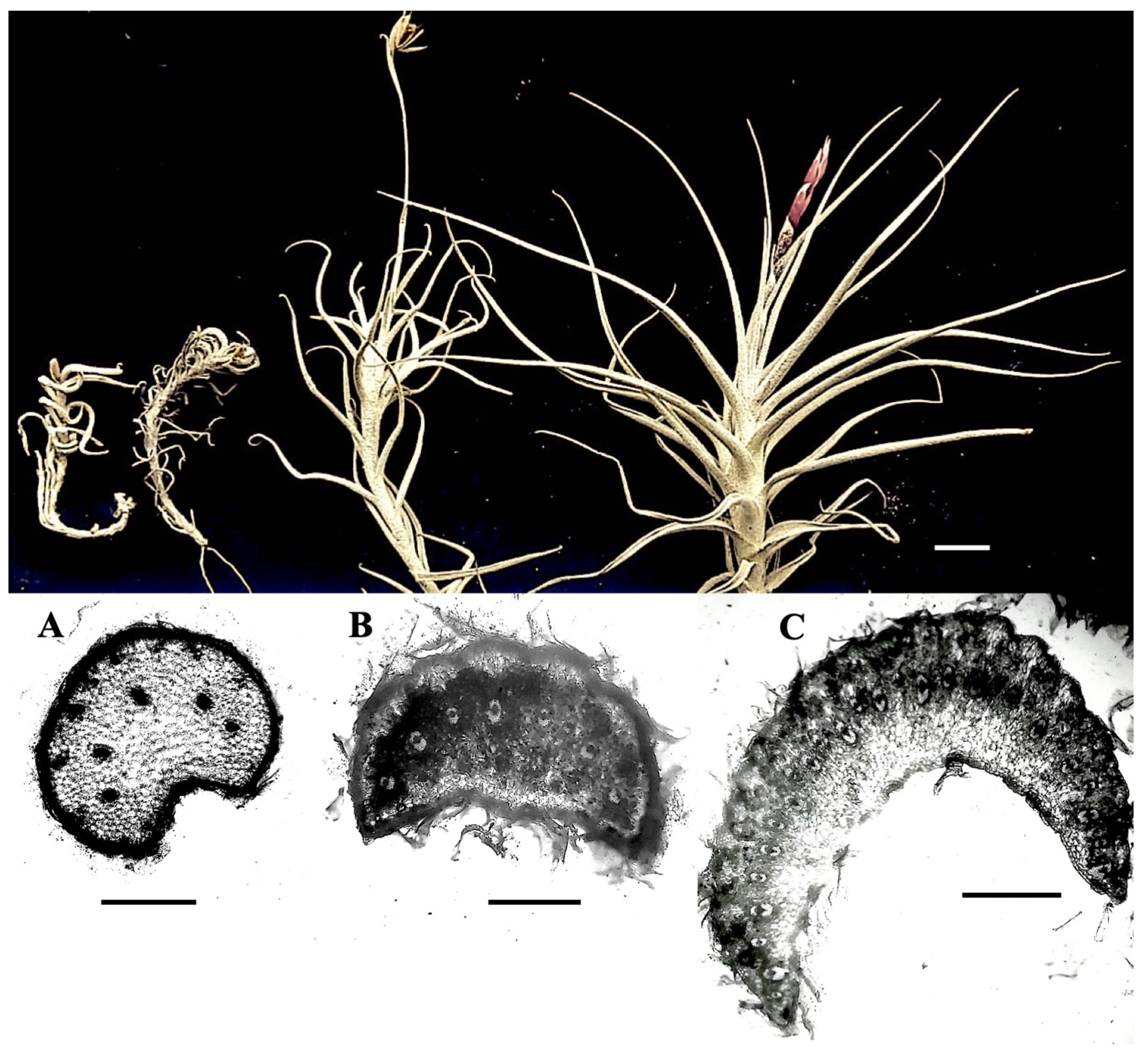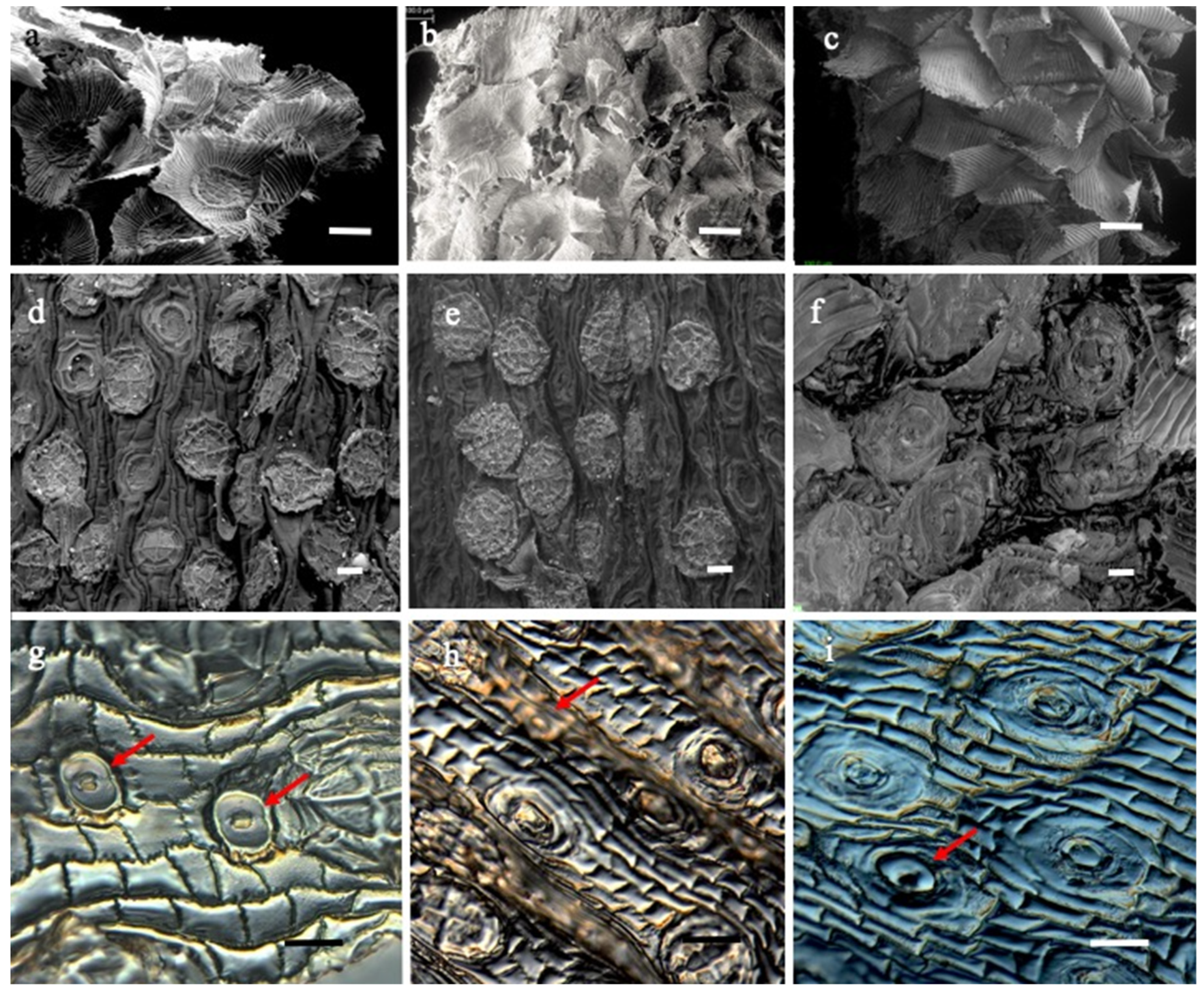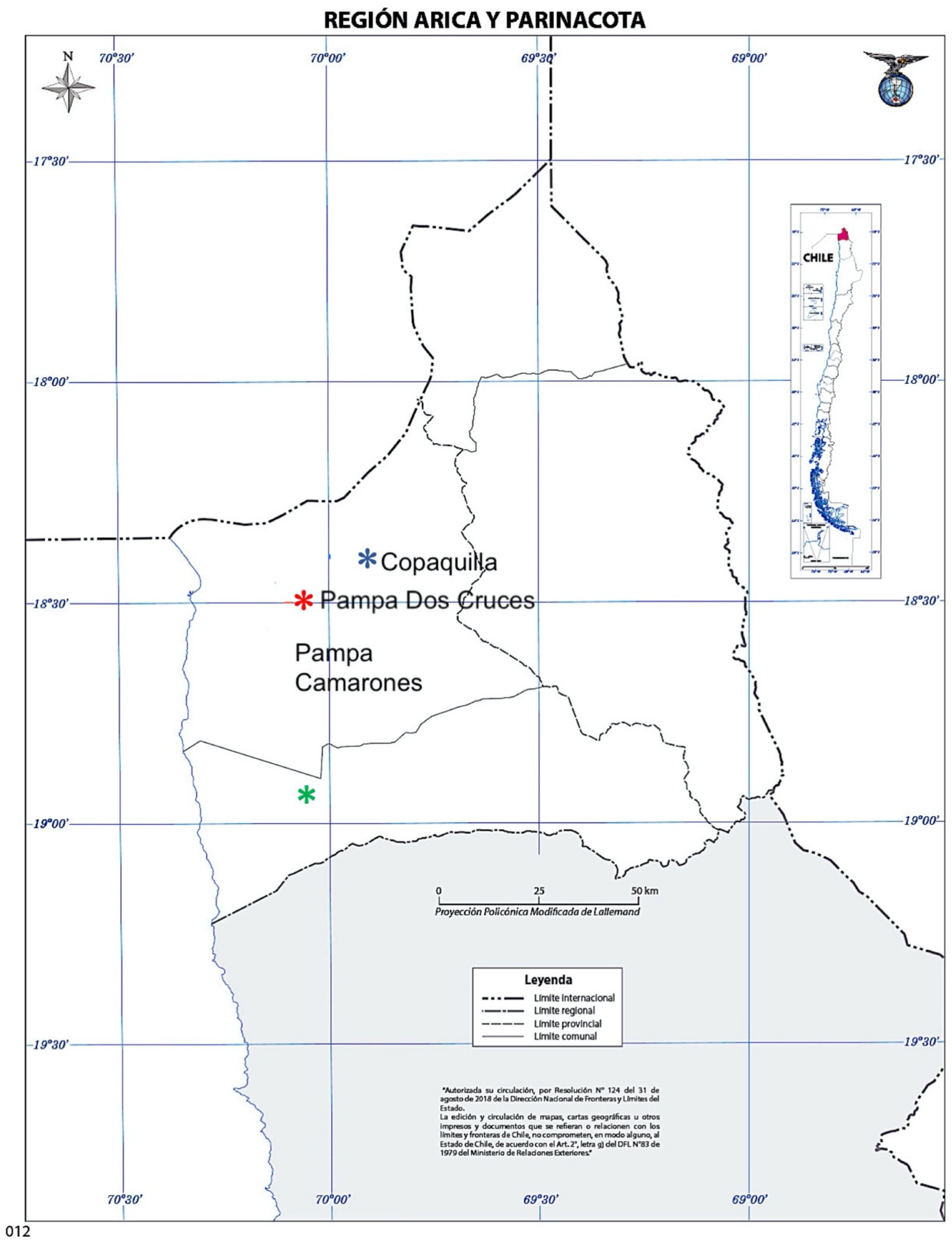Foliar Anatomy of Three Native Species of Tillandsia L. from the Atacama Desert, Chile
Abstract
1. Introduction
2. Results
3. Discussion
4. Materials and Methods
Author Contributions
Funding
Data Availability Statement
Acknowledgments
Conflicts of Interest
References
- Benzing, D. Bromeliaceae: Profile of an Adaptative Radiation; Cambridge University Press: Cambridge, UK, 2000; 665p. [Google Scholar]
- Proenca, S.; Sajo, M.D.G. Anatomy of the floral scape of Bromeliaceae. Rev. Bras. Bot. 2008, 31, 399–408. [Google Scholar] [CrossRef][Green Version]
- Benzing, D.; Seeman, J.; Renfrow, A. The foliar epidermis in Tillandsioideae (Bromeliaceae) and its role in habitat selection. Am. J. Bot. 1978, 65, 359–365. [Google Scholar] [CrossRef]
- González, A.; Fariña, J.; Pinto, R.; Pérez, C.; Weathers, K.; Armesto, J.; Marquet, P. Bromeliad growth and stoichiometry: Responses to atmospheric nutrient inputs in fog-dependent ecosystems of the hyper-arid Atacama Desert, Chile. Oecologia 2011, 167, 835–845. [Google Scholar] [CrossRef] [PubMed]
- De Melo, M.; Paiva, B.; Cavalcante, Y.; Aona, S.; Das Graças, M.; Wanderley, L.; Hilo De Souza, E. Tillandsia itatiensis: A new species of Tillandsia L. (Bromeliaceae) from Bahia, Brazil. Phytotaxa 2020, 456, 186–194. [Google Scholar]
- De Souza, E.H.; De Melo, M.; Yuriko, M.; Aona, S.; Vidigal, F.; Souza, D.; Leme, E. Tillandsia oliveirae (Bromeliaceae): A new species from an inselberg in Bahia, Brazil. Phytotaxa 2021, 527, 60–66. [Google Scholar] [CrossRef]
- Vicente-Rivera, L.; García-Martínez, R.; Beutelspacher, C. Nuevos registros para la flora de Chiapas, México. Lacandonia 2021, 15, 29–40. [Google Scholar]
- Contreras, S.; Landahur, M.; García, K.; Latorre, C.; Reyers, M.; Rethemeyer, J.; Jaeschke, A. Leaf wax composition and distribution of Tillandsia landbeckii reflects moisture gradient across the hyperarid Atacama Desert. Plant Syst. Evol. 2022, 308, 8. [Google Scholar] [CrossRef]
- Benzing, D. Bromeliad trichomes: Structure, function and ecological significance. Selbyana 1976, 1, 330–348. [Google Scholar]
- Benzing, D.; Renfrow, A. Significance of the patterns of CO2 exchange to the ecology and phylogeny of the Tillandsioideae (Bromeliaceae). Bull. Torrey Bot. Club 1971, 98, 322–327. [Google Scholar] [CrossRef]
- Cereceda, P.; Larraín, H.; Osses, P.; Farías, M.; Egaña, I. The climate of the coast and fog zone in the Tarapacá Region, Atacama Desert, Chile. Atmos. Res. 2008, 87, 301–311. [Google Scholar] [CrossRef]
- Cereceda, P.; Larraín, H.; Osses, P.; Farías, M.; Egaña, I. The spatial and temporal variability of fog and its relation to fog oases in the Atacama Desert, Chile. Atmos. Res. 2008, 87, 312–323. [Google Scholar] [CrossRef]
- Bahamonde, R.P. Tillandsia del Norte de Chile y del Extremo Sur del Perú; Autor-Editor Genérico: Santiago de, Chile, 2005; 135p. [Google Scholar]
- Pinto, R.; Barría, I.; Marquet, P. Geographical distribution of Tillandsia lomas in the Atacama Desert, northern Chile. J. Arid Environ. 2006, 65, 543–552. [Google Scholar] [CrossRef]
- Borthagaray, A.; Fuentes, M.; Marquet, P. Vegetation pattern formation in a fog-dependent ecosystem. J. Theor. Biol. 2010, 265, 18–26. [Google Scholar] [CrossRef] [PubMed]
- Samaniego, H.; Serandour, G.; Milne, B. Numerical Ecology. Popul. Ecol. 1998, 54, 212–223. [Google Scholar]
- Rundel, O.; Dillon, O.; Palma, B.; Mooney, A.; Gulmon, S.; Ehleringer, J. The phytogeography and ecology of the coastal Atacama and Peruvian Desert. Aliso 1991, 13, 1–49. [Google Scholar] [CrossRef]
- Rundel, P.; Palma, B.; Dillon, M.; Sharifi, M.; Nilsen, E.; Boonpragob, K. Tillandsia landbeckii in the coastal Atacama Desert of northern Chile. Rev. Chil. Hist. Nat. 1997, 70, 341–349. [Google Scholar]
- Börgel, R. Geomorfología de Chile; Instituto Geográfico Militar: Santiago, Chile, 1983; 182p. [Google Scholar]
- Kalin, M.; Squeo, F.; Armesto, J.; Villagrán, C. Effects of aridity in Plant Diversity in the northern Chilean Andes: Results of a Natural Experiment. Ann. Mo. Bot. Gard. 1988, 75, 55–78. [Google Scholar]
- Ehleringer, J.; Rundel, P.; Palma, B.; Mooney, H. Carbon isotope ratios of Atacama Desert plants reflect hyperaridity of region in northern Chile. Rev. Chil. Hist. Nat. 1998, 71, 79–86. [Google Scholar]
- Marquet, P.; Bozinovic, F.; Bradshaw, G.; Cornelius, C.; González, H.; Gutiérrez, J.; Hajek, E.; Lagos, J.; López-Cortés, F.; Núñez, L.; et al. Ecosystems of the Atacama Desert and adjacent Andean area in northern Chile. Rev. Chil. Hist. Nat. 1998, 71, 593–617. [Google Scholar]
- Latorre, C.; González, L.; Quade, J.; Fariña, M.; Pinto, R.; Marquet, P. Establishment and formation of fog-dependent Tillandsia landbeckii dunes in the Atacama Desert: Evidence from radiocarbon and stable isotopes. J. Geophys. Res. 2011, 116, 1–12. [Google Scholar] [CrossRef]
- Rodríguez, R.; Marticorena, C.; Alarcón, D.; Báez, C.; Cavieres, L.; Finot, V.; Fuentes, N.; Kiesling, A.; Pauchard, A.; Ruiz, E.; et al. Catálogo de las plantas vasculares de Chile. Gayana Bot. 2018, 75, 1–430. [Google Scholar] [CrossRef]
- Mauseth, J. Plant Anatomy; The Benjamin/Cummings Publishing Company, Inc.: San Francisco, CA, USA, 1988; 560p. [Google Scholar]
- R Core Team. R: A Language and Environment for Statistical Computing. R Foundation for Statistical Computing, Vienna, Austria. 2020. Available online: https://www.R-project.org/ (accessed on 3 December 2021).
- Benzing, D.; Burt, K. Foliar permeability among twenty species of the Bromeliaceae. Bull. Torrey Bot. Club 1970, 97, 269–279. [Google Scholar] [CrossRef]
- Medina, E. Eco-Fisiología y Evolución de las Bromeliaceae; Boletín de la Academia Nacional de Ciencias: Córdoba, Spain, 1990; Volume 59, Issues 1 and 2. [Google Scholar]
- Reinert, F.; Meirelles, S. Water acquisition strategy shifts in the heterophyllous saxicolous bromeliad Vriesea eniculate (Wawra) Wawra. Selbyana 1993, 14, 80–88. [Google Scholar]
- Werker, E. Trichome Diversity and Development. Adv. Bot. Res. 2000, 31, 1–35. [Google Scholar]
- Schulz, N.; Boisier, J.; Aceituno, P. Climate change along the arid coast of northern Chile. Int. J. Climatol. 2011, 32, 1803–1814. [Google Scholar] [CrossRef]
- Zizka, G.; Schmidt, M.; Schulte, K.; Nova, P.; Pinto, R.; König, K. Chilean Bromeliaceae: Diversity, distribution and evaluation of conservation status. Biodivers. Conserv. 2009, 18, 2449–2471. [Google Scholar] [CrossRef]
- Cach-Pérez, M.; Andrade, J.; Reyes-García, C. La susceptibilidad de las Bromeliáceas epífitas al cambio climático. Bot. Sci. 2014, 92, 157–168. [Google Scholar] [CrossRef]
- Susan-Tepetlan, T.M.; Velázquez-Rosas, N.; Krömer, T. Changes in the functional characteristics of vascular epiphytes of mountain mesophyll forest and secondary vegetation in the central region of Veracruz, Mexico. Bot. Sci. 2015, 93, 1–11. [Google Scholar] [CrossRef]
- Benz, B.; Martin, C. Foliar trichomes, boundary layers, and gas Exchange in 12 species of epiphytic Tillandsia (Bromeliaceae). J. Plant Physiol. 2006, 163, 648–656. [Google Scholar] [CrossRef]
- Mez, C. Physiologishe Bromeliaceen-Studien. I. Die Wasserokonomie der extrem atmospharishen Tillandsien. Jahrbücher Für Wiss. Bot. 1904, 40, 157–229. [Google Scholar]
- Haberlandt, G. Physiological Plant Anatomy; MacMillan & Co. Limited: London, UK, 1914; 812p. [Google Scholar]
- Pampa Camarones PV Solar Plant. 2013. Available online: https://www.bnamericas.com/en/project-profile/pampa-camarones-pv-solar-plant (accessed on 23 September 2021).
- Preece, A.; Press, I. Manual of Histologic Techniques, 3rd ed.; Little Brown & Co.: Boston, MA, USA, 1972; pp. 222–223. [Google Scholar]
- Meinzer, F.; Goldstein, G. Some consequences of leaf pubescens in the Andean Giant rosette plant Espeletia timotensis. Ecology 1985, 66, 512–520. [Google Scholar] [CrossRef]
- Molina-Montenegro, M. Variación de la pubescencia foliar en plantas y sus implicaciones funcionales a lo largo de gradientes altitudinales. Ecosistemas 2008, 17, 146–154. [Google Scholar]




 Tillandsia landbeckii, Pampa Camarones, 1010 m; 2.
Tillandsia landbeckii, Pampa Camarones, 1010 m; 2.  T. marconae, Pampa Dos Cruces, 1000 m; and 3.
T. marconae, Pampa Dos Cruces, 1000 m; and 3.  T. virescens, Pukara de Copaquilla, 3050 m. (Source: Google Earth).
T. virescens, Pukara de Copaquilla, 3050 m. (Source: Google Earth).
 Tillandsia landbeckii, Pampa Camarones, 1010 m; 2.
Tillandsia landbeckii, Pampa Camarones, 1010 m; 2.  T. marconae, Pampa Dos Cruces, 1000 m; and 3.
T. marconae, Pampa Dos Cruces, 1000 m; and 3.  T. virescens, Pukara de Copaquilla, 3050 m. (Source: Google Earth).
T. virescens, Pukara de Copaquilla, 3050 m. (Source: Google Earth).
| OCd | Sd | Td | PTa (µm2) | Lw (mm) | Ll (mm) | La (mm2) | NVc | |
|---|---|---|---|---|---|---|---|---|
| Abaxial side | ||||||||
| T. landbeckii | 1.9 × 10−2 b | 3 × 10−4 a | 1.22 × 10−3 b | 66048.5 a | 2.3 a | 42.9 a | 96.8 a | 65 a |
| T. marconae | 1.9 × 10−2 b | 1 × 10−4 a | 0.87 × 10−3 a | 105114.2 b | 9.4 b | 110.8 b | 1040.6 b | 85 b |
| T. virescens | 1.6 × 10−2 a | 1 × 10−4 a | 1.01 × 10−3 a | 174475.8 c | 2.1 a | 20.4 c | 42.1 c | 62 a |
| Adaxial side | ||||||||
| T. landbeckii | 1.6 × 10−2 a | 0 a | 1.13 × 10−3 a | --- | ||||
| T. marconae | 1.7 × 10−2 a | 0 a | 0.97 × 10−3 a | --- | ||||
| T. virescens | 1.7 × 10−2 a | 0 a | 1.08 × 10−3 a | --- | ||||
| T. marconae | T. landbeckii | T. virescens | |
|---|---|---|---|
| Pyllotaxis | Rosette | Rosette | Distichous |
| Conduplicate leaf | The whole blade | The whole blade | The first basal third is conduplicate and becomes cylindrical towards the apex |
| Marginal configuration | Crenate | Crenate | Entire |
| Epidermis | Uniseriate with thick homogenous walls rectangular in shape and straight anticlinal walls | Uniseriate with thick homogenous walls rectangular in shape and straight anticlinal walls | Uniseriate with thick homogenous walls rectangular in shape and straight anticlinal walls |
| Ground parenchyma: Hypodermis | Hypodermal layers of large, thin-walled, isodiametric parenchyma cells that store water are present close to the abaxial leaf surface. On the opposite side, the hypodermis forms isolated clusters of a few enlarged cells | Close to the abaxial leaf surface, hypodermis is present in the form of 2–3 layers of thin-walled, isodiametric parenchyma cells. On the opposite side, the hypodermis forms wide isolated clusters of enlarged cells | Globose translucent isodiametric parenchyma cells and chlorophyll-bearing cells are homogeneously distributed throughout the area |
| Ground parenchyma: Chlorenchyma | The chlorenchyma is formed by angular, isodiametric chlorophyll-bearing cells, isolated from the abaxial leaf surface by many layers of water-storage cells | The chlorenchyma is formed by angular, isodiametric chlorophyll-bearing cells, isolated from the abaxial leaf surface by a couple of hypodermal layers of water-storage cells | Chlorophyll-bearing and water-storage cells are intermingled |
| Vascular bundles | The vascular bundles are distributed in a linear series following the shape of the leaf, in the area occupied by chlorophyll-bearing cells | The vascular bundles are distributed in a linear series following the shape of the leaf, in the area occupied by chlorophyll-bearing cells | The vascular bundles are distributed throughout the area in the middle of the ground parenchyma, in a double concentric series. |
| Bundle sheath | Bundle sheath one cell thick, surrounded by a great amount of thick-walled schlerenchyma cells | Bundle sheath one cell thick, surrounded by a great amount of thick-walled schlerenchyma cells | Double bundle sheath; the inner one formed by small cells and the outer one formed by large cells without chlorophyll of the ground parenchyma |
| Stomata | Stomata are anomocytic, present only in the abaxial epidermis. | Stomata are anomocytic, present only in the abaxial epidermis. | Stomata are anomocytic, present only in the abaxial epidermis. |
| Scales | Peltate trichome in both leaf surfaces 4 + 8 + 16 + 85 (disc cells, ring cells, veil) | Peltate trichome in both leaf surfaces 4 + 8 + 16 + 65 (disc cells, ring cells, veil) | Peltate trichome in both leaf surfaces 4 + 8 + 16 + 62 (disc cells, ring cells, veil) |
| Species | Location Altitude (m) | Geographical Coordinates | Collection Date | |
|---|---|---|---|---|
| S | W | |||
| T. landbeckii | Pampa Camarones1010 | 18°52′29.66″ S | 70°7′10.85″ W | 21 July 2017 |
| T. marconae | Pampa dos Cruces1000 | 18°28′43.48″ S | 70°5′16.69″ W | 21 July 2017 |
| T. virescens | Pukara de Copaquilla3050 | 18°23′34.49″ S | 69°38′32.19″ W | 14 March 2018 |
Publisher’s Note: MDPI stays neutral with regard to jurisdictional claims in published maps and institutional affiliations. |
© 2022 by the authors. Licensee MDPI, Basel, Switzerland. This article is an open access article distributed under the terms and conditions of the Creative Commons Attribution (CC BY) license (https://creativecommons.org/licenses/by/4.0/).
Share and Cite
Belmonte, E.; Arriaza, B.; Arismendi, M.; Sepúlveda, G. Foliar Anatomy of Three Native Species of Tillandsia L. from the Atacama Desert, Chile. Plants 2022, 11, 870. https://doi.org/10.3390/plants11070870
Belmonte E, Arriaza B, Arismendi M, Sepúlveda G. Foliar Anatomy of Three Native Species of Tillandsia L. from the Atacama Desert, Chile. Plants. 2022; 11(7):870. https://doi.org/10.3390/plants11070870
Chicago/Turabian StyleBelmonte, Eliana, Bernardo Arriaza, Mabel Arismendi, and German Sepúlveda. 2022. "Foliar Anatomy of Three Native Species of Tillandsia L. from the Atacama Desert, Chile" Plants 11, no. 7: 870. https://doi.org/10.3390/plants11070870
APA StyleBelmonte, E., Arriaza, B., Arismendi, M., & Sepúlveda, G. (2022). Foliar Anatomy of Three Native Species of Tillandsia L. from the Atacama Desert, Chile. Plants, 11(7), 870. https://doi.org/10.3390/plants11070870






